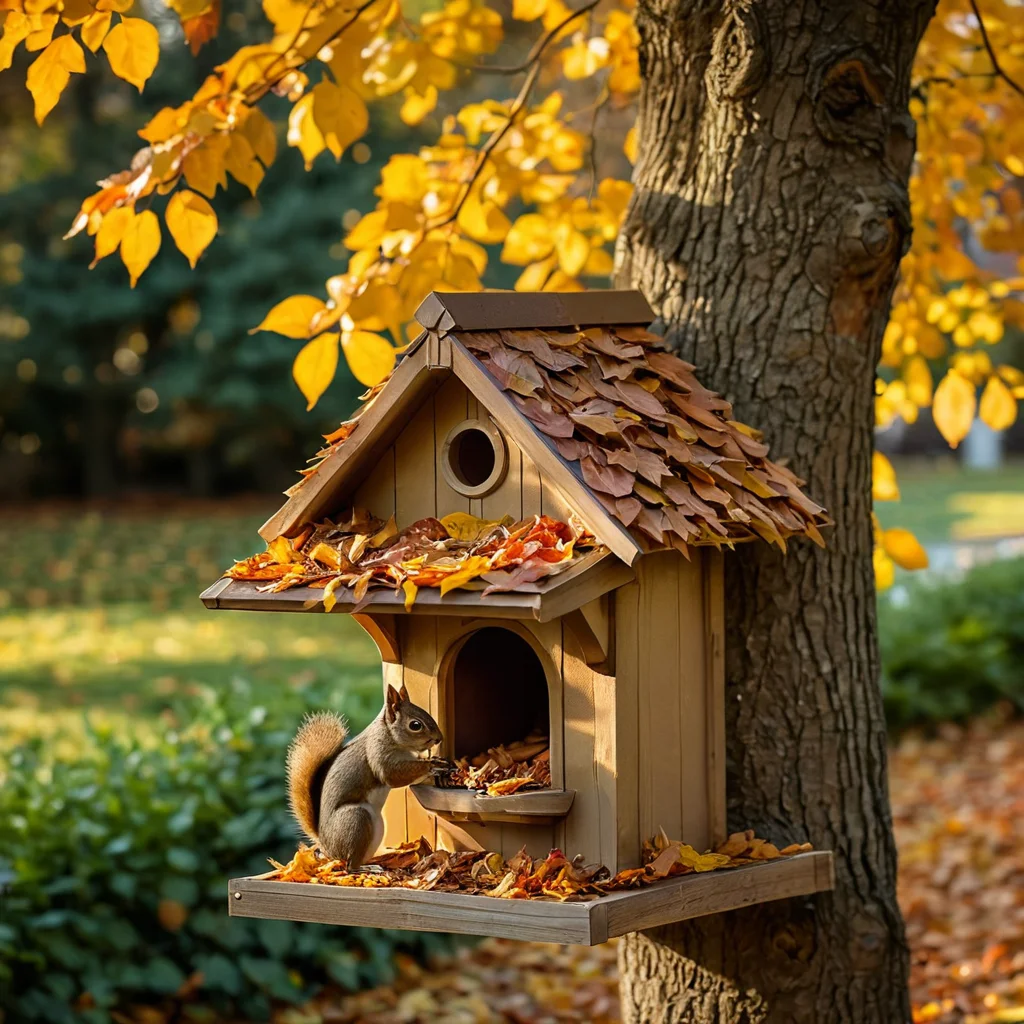Remember how pleasant it is to watch small, nimble creatures scurrying among the trees. Their clumsy jumps, busy rustling in the leaves, their thriftiness – all this brings a special charm to our world. And imagine that you can not only observe but also help these fluffy creatures by creating a cozy corner for them right on your property. I have always believed that a garden is not just a place for flowers and vegetables, but a whole world where birds, insects, and sometimes larger guests like squirrels live. And when I first saw how skillfully a squirrel handled a homemade feeder, I realized: this is real magic.
Creating a squirrel feeder house is not just an engaging activity, but also a wonderful way to bring harmony to your garden’s ecosystem. You give animals the opportunity to find food in difficult times, and in return, you get the chance to observe their lives, which is therapeutic in itself. It’s such a small contribution to a big cause that brings a lot of positive emotions.
Why is a Squirrel Feeder House Needed in the Garden?
It might seem that squirrels are self-sufficient creatures, capable of finding food in nature. And generally, this is true. However, there are several reasons why installing a feeder will be a boon for both the animals and you:
- Support in Difficult Times: In winter, when snow covers the ground and food supplies dwindle, it can be difficult for squirrels to find sustenance. A feeder with regular replenishment becomes a real lifesaver for them. In summer, during periods of drought or poor harvest, it can also be very useful.
- Nature Observation: Admit it, watching a fluffy squirrel cautiously approach a feeder, take a nut, and quickly carry it away is a real pleasure. It’s a great opportunity for children (and adults!) to get acquainted with the animal world in its natural environment without disturbing it.
- Assistance in Reproduction: A balanced diet that a feeder can provide contributes to better health and, consequently, successful reproduction of squirrels. This is important for maintaining the population.
- Natural Garden Decor: A beautifully made feeder can itself become an interesting element of the garden landscape. It will add coziness and show that your plot is not just a place for humans, but also for other inhabitants.
- Development of Observation and Care: Maintaining the feeder, filling it with treats, is an excellent way to instill a sense of responsibility and care for living creatures in children (and yourself!).
Personally, I noticed that after installing the first feeder, our garden seemed more alive. There were more bird songs, and the squirrels became real stars! Believe me, it’s a very pleasant feeling to know that you are doing something good for those who live nearby.
Types of Squirrel Feeder Houses: Choosing Design and Materials
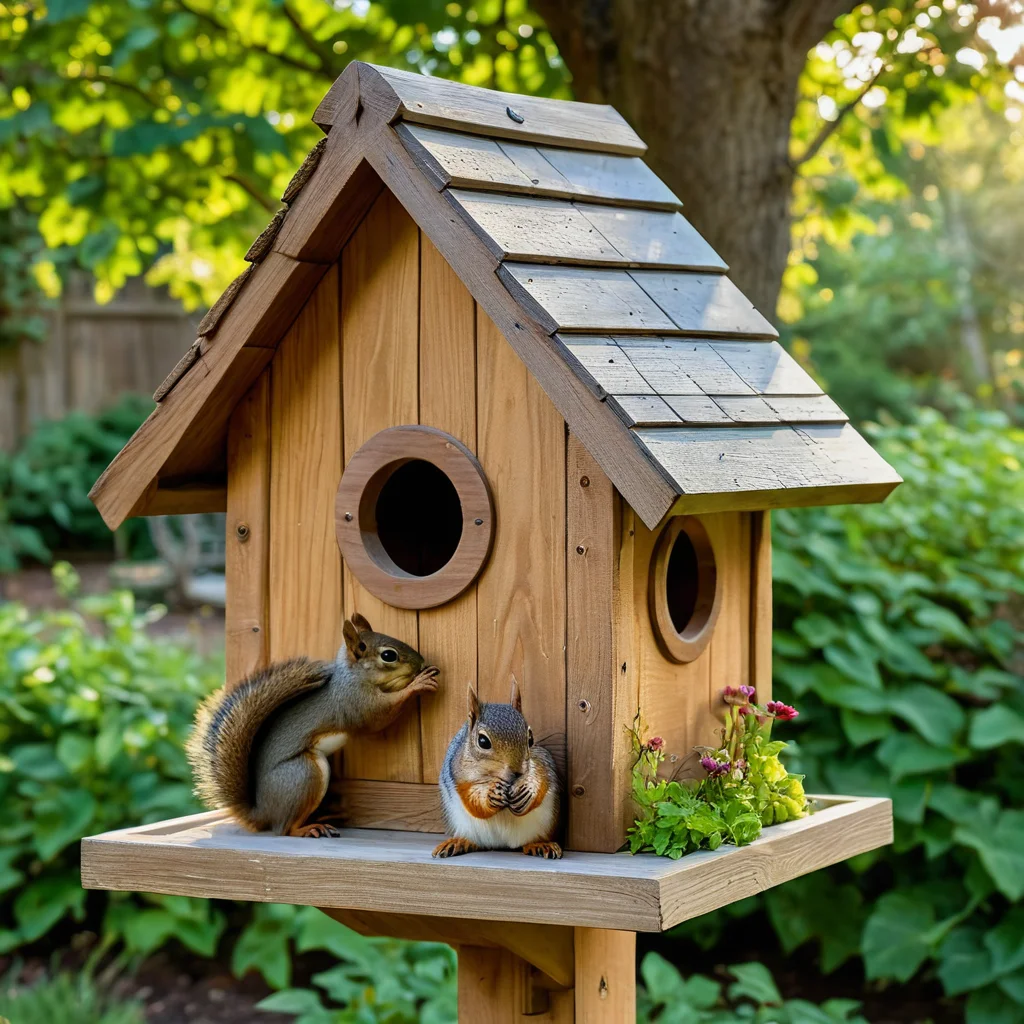
Before you start creating, it’s worth understanding what kinds of feeders exist and what’s best to choose for your garden. There aren’t many basic designs, but each has its own characteristics.
Simple Open Platforms
This is perhaps the most elementary option. It’s a small platform with sides, sometimes with a roof. Advantages:
- Ease of Manufacturing: Minimal parts, minimal time and effort.
- Easy Access for Squirrels: Animals can easily climb up and take food.
- Inexpensive Materials: Often, you can use leftover wood scraps.
Disadvantages:
- Lack of Protection from Weather: Food can get wet in rain or snow.
- Access for Birds: Birds often use these feeders too, which can reduce the portion for squirrels.
Closed Box Feeders
This is a more complex, but also more functional design. It usually looks like a small box with one or two entrance/exit holes and a platform in front.
- Protection from Weather: Rain and snow don’t get inside, keeping the food dry.
- Limited Access for Others: Less chance of birds or other small rodents eating the food.
- Coziness and Safety: Squirrels feel more protected in such a house.
Disadvantages:
- More Difficult to Manufacture: Requires more woodworking skills.
- Requires Correct Size: Too small an opening might not be suitable, too large might attract unwanted guests.
Carousel Feeders or Feeders with Rotating Elements
These are more advanced designs that sometimes look like miniature windmills or houses with rotating elements. They can be interesting from a design perspective, but they generally don’t offer significant advantages to squirrels over a simple box feeder.
As for materials, the main thing is safety and durability:
- Wood: The best choice is natural, untreated wood. Avoid plywood and particleboard, as they may contain harmful glues and resins. Pine, spruce, larch, and cedar are suitable. It’s important that the wood is dry and free from mold.
- Fasteners: Use galvanized or stainless steel screws and nails to prevent rust.
- Finishing: It is highly undesirable to use paints, varnishes, or impregnations, especially inside the house. If you want to color the feeder, choose natural water-based dyes for exterior finishing, but it’s best to leave the wood natural.
I always prefer simple but sturdy wooden designs. My most successful feeders were made from scrap boards left over from building a gazebo. The main thing is that it’s clean, safe, and functional.
Where to Best Place a Squirrel Feeder in the Yard: Choosing the Ideal Spot

The correct placement of the feeder is key to ensuring that squirrels find it and feel safe. Here are a few key points to consider:
Safety First
Squirrels are timid creatures. They need to feel protected from predators (cats, dogs, birds of prey) and from unexpected intrusions. Therefore:
- Avoid Open, Visible Areas: Do not place the feeder in the middle of the lawn.
- There Should Be Shelter Nearby: Ideally, there should be dense bushes or branched trees nearby where a squirrel can quickly hide.
- Do Not Place Too Low: At a height of less than 1.5-2 meters from the ground – this makes it vulnerable to ground predators.
Proximity to Natural Habitat
If your property has trees, especially coniferous ones or those with dense foliage, this is an ideal location. Squirrels often live and nest there.
- On a Tree: The feeder can be attached directly to the tree trunk or a thick branch. Ensure the tree is healthy and strong.
- Near a Tree: If you cannot attach the feeder to a tree, install it on a support (post) near the tree.
Convenience for You
Don’t forget that the feeder will need to be regularly refilled and cleaned. Therefore, choose a location that is convenient for you to access, preferably not too far from the house.
- Visual Access: It’s desirable to be able to observe the feeder from a house window or terrace.
- Protection from Direct Sunlight: Especially in summer, to prevent the food from overheating.
Mistakes to Avoid
- Too Close to Paths or Active Recreation Areas: Constant human activity will scare squirrels.
- Near Loud Noises: Do not install the feeder near noisy objects (e.g., a pump station).
- Excessive Humidity: Avoid low-lying areas where water collects.
I personally prefer to hang feeders on old apple or pine trees. They serve as excellent landmarks for squirrels, and it’s always quiet and peaceful there. Once, I hung a feeder too low, and the neighbor’s cat kept trying to get into it. I had to move it higher.
How to Make a Simple Squirrel Feeder House Yourself: Step-by-Step Instructions
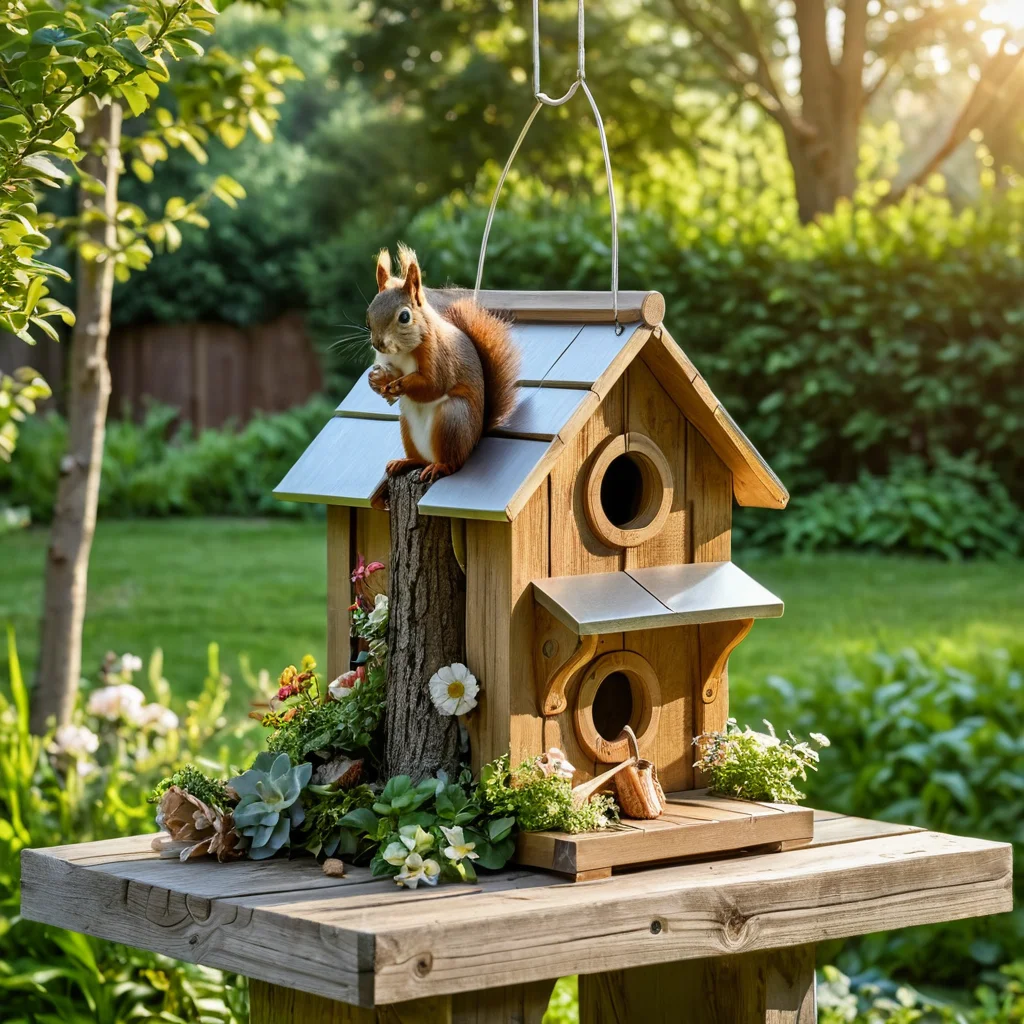
Making a feeder yourself is a great opportunity to be creative and do something useful. I suggest the simplest but most effective option – a closed box feeder. Almost anyone can make it.
Materials and Tools Needed
- Wooden Boards: About 1.5-2 cm thick. Untreated wood (pine, spruce) is best.
- Screws or Nails: Galvanized or stainless steel.
- Saw: Handheld or electric.
- Drill and Drill Bits: For holes.
- Measuring Tape and Pencil: For marking.
- Sandpaper: For smoothing edges.
- Hanging Hardware: For example, a loop or hook.
Manufacturing Steps
- Prepare the Parts: We will need the following parts (approximate dimensions, can be adapted):
- Bottom: 15×15 cm (1 pc.)
- Side Walls: 15×20 cm (2 pcs.)
- Front Wall: 15×20 cm (1 pc.)
- Back Wall: 15×25 cm (1 pc. – elongated for attaching to a tree)
- Roof: 20×20 cm (1 pc. – a small overhang)
- Marking and Cutting: Carefully cut out all parts according to the marked dimensions.
- Edge Finishing: Sand all cuts with sandpaper to remove burrs and make the edges smooth. This is important for squirrel safety.
- Create the Entrance: Drill a round hole about 5-6 cm in diameter in the front wall. Place it in the upper part of the wall. You can also add a small perch – a small block under the hole.
- Assemble the Box: Start assembly with the bottom. Attach the side walls to it, then the front and back. Use screws or nails. Ensure all parts fit tightly together to avoid gaps.
- Install the Roof: Attach the roof on top. It should overhang the front wall slightly to provide better protection from precipitation.
- Attachment: Screw a loop or hook to the back wall (the longer one) for hanging the feeder.
Assembly Tips:
- Before assembly, you can lightly treat the exterior of the wood (not the interior!) – for example, with natural oil to make it last longer.
- Ensure there are no protruding nails or screws inside the house.
- If you are making a feeder for a colder climate, you can include a small recess or “vestibule” inside to keep the squirrels warmer.
My first feeder was very simple, assembled in literally an hour. I used old fence boards. And you know, the squirrels accepted it with such joy! The main thing is that it’s functional and safe.
What Materials Are Safe for Squirrels: An Overview of Suitable Wood and Fasteners
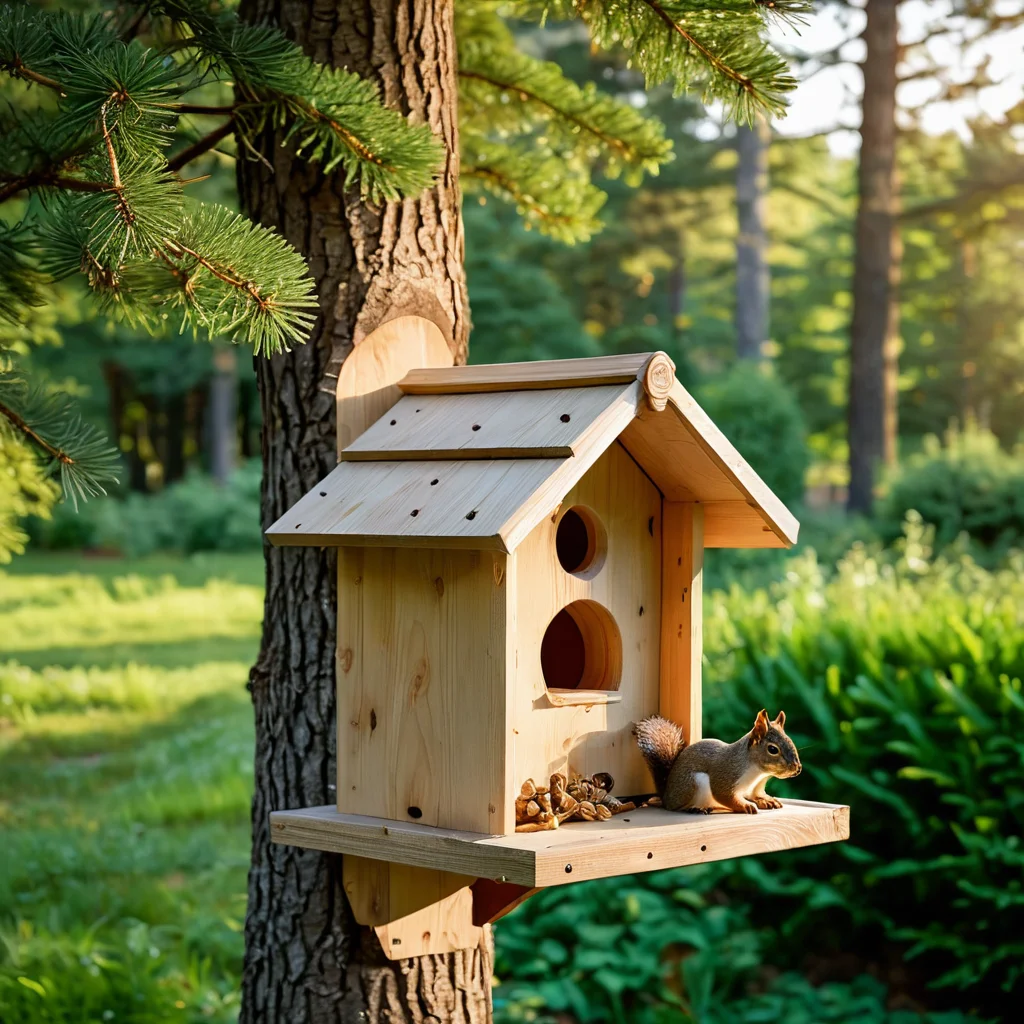
When we make something for animals, safety should always come first. Squirrels are delicate creatures, and incorrectly chosen materials can harm them. Let’s figure out what to use and what to strictly avoid.
Choosing Wood
Ideal Options:
- Natural Wood: Pine, spruce, cedar, larch. These wood species are quite accessible, easy to work with, and most importantly, safe for animals. It’s important that the wood is dry, without signs of rot or mold.
- Untreated Wood: It’s best to use wood without any chemical treatment. Squirrels may gnaw on the structure, and if the wood contains harmful substances, they can enter the animal’s body.
What to Avoid:
- Plywood, Particleboard, MDF: These materials contain glues and resins that can be toxic. Additionally, they do not withstand moisture well and swell quickly.
- Chemically Treated Wood: Any antiseptics, varnishes, paints (especially solvent-based) for interior finishing are unacceptable.
- Rotten or Moldy Wood: It’s obvious that such materials are dangerous to health.
Fasteners
Recommended:
- Galvanized or Stainless Steel Screws and Nails: They do not rust, which is important for the durability and aesthetics of the structure.
- Strong Cord or Rope: If you plan to hang the feeder, use natural ropes (hemp, cotton) or a strong synthetic cord that will not fray.
What to Avoid:
- Regular Black Screws: They rust quickly, look unaesthetic, and can leave rust streaks.
- Too Thin or Weak Fasteners: The feeder must be securely attached.
Finishing and Painting
Important Points:
- Maximum Natural Appearance: Squirrels don’t care about the color of the feeder. It’s best to leave the wood natural.
- If You Really Want to Decorate: Use only natural water-based paints or animal-safe dyes for exterior finishing. Never paint the inside of the feeder!
In my experience, squirrels don’t pay attention to the appearance of the feeder, but they are very sensitive to smells. Therefore, the more natural the materials, the better. I always sand all edges so the animals don’t get hurt.
What to Feed Squirrels in a Feeder: Healthy and Harmful Treats
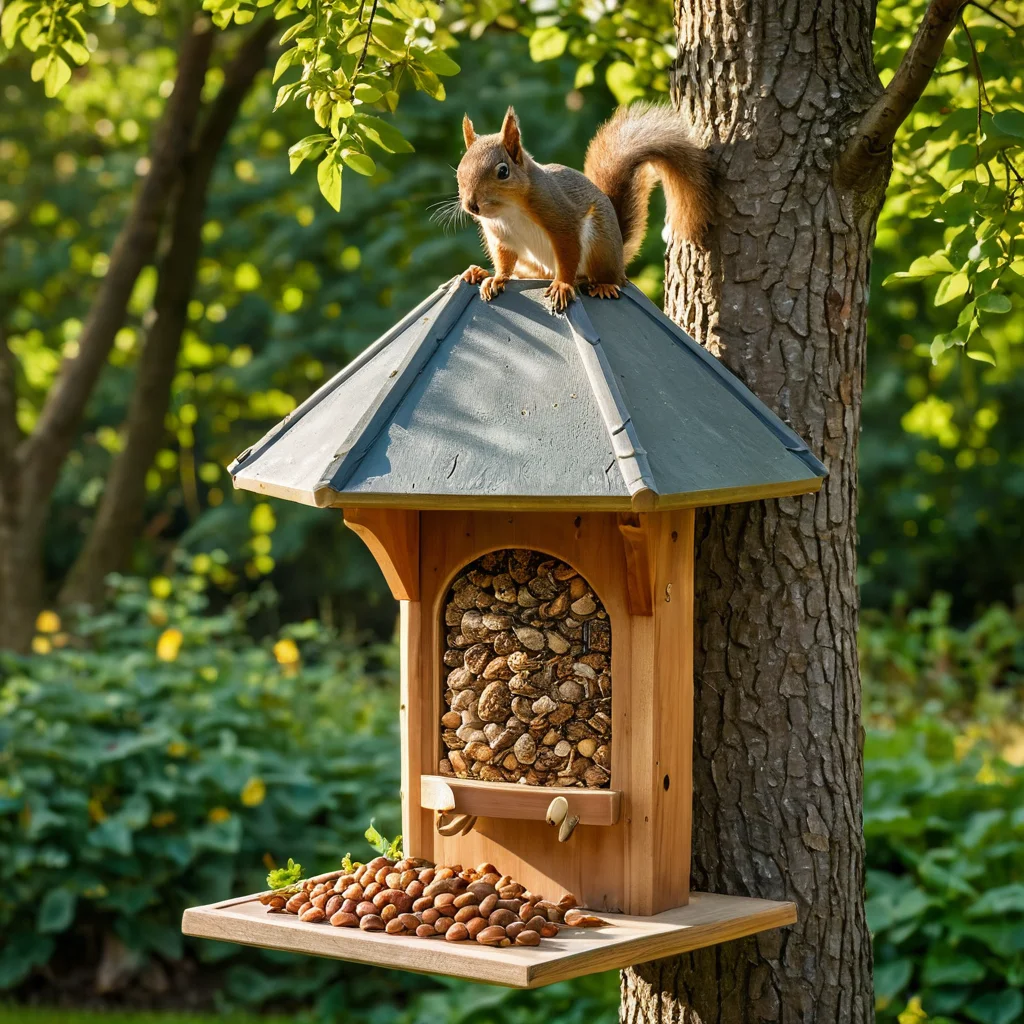
For the feeder to truly help squirrels and not harm them, it’s very important to know what you can treat them with and what is strictly forbidden. Proper nutrition is the key to the health and longevity of these little animals.
Healthy Treats
The main diet of a squirrel consists of nuts, seeds, mushrooms, berries, and young shoots. You can add the following to the feeder:
- Nuts: Walnuts, hazelnuts, pine nuts, peanuts (in shell and shelled). This is the most popular and nutritious food.
- Seeds: Sunflower seeds (unsalted, unroasted), pumpkin seeds.
- Dried Berries: Rosehip, hawthorn, rowan (in small quantities).
- Dried Mushrooms: Porcini, fly agaric, chanterelles. Squirrels love to hoard mushrooms.
- Vegetables: Carrots, pumpkin, zucchini (in small pieces).
- Fruits: Apples, pears (small pieces, without cores).
- Special Grain Mixes: Available at pet stores.
Important:
- Do Not Overfeed! Squirrels are hoarders themselves, and they don’t need extra food.
- Offer a Variety of Food.
- Ensure the food is fresh and mold-free.
Harmful Foods to Avoid
Many foods that we eat can be dangerous for squirrels:
- Salty, Fried, Smoked: Chips, crackers, salted peanuts, any fried food – these are a direct path to digestive and health problems.
- Sweets: Candies, cookies, pastries, chocolate. Squirrels lack the enzymes to digest sugar in such quantities.
- Bread: White and black bread, especially fresh, can cause bloating and stomach problems.
- Exotic Fruits: Citrus fruits, kiwi, mango can cause allergies or upset stomachs.
- Dairy Products: Squirrels are lactose intolerant.
- Fruit Pits: Some pits (e.g., apricot pits) contain hydrocyanic acid.
- Moldy Foods: This is the biggest danger!
I always try to keep a mix of nuts and seeds in the feeder. Squirrels love walnuts. But I never give them bread. I remember once a neighbor threw leftover holiday food into the feeder – cookies, cheese… The squirrels tried it, of course, but then they didn’t come to the feeder for a long time. Natural foods are best.
Caring for a Squirrel Feeder House: Cleaning and Maintenance
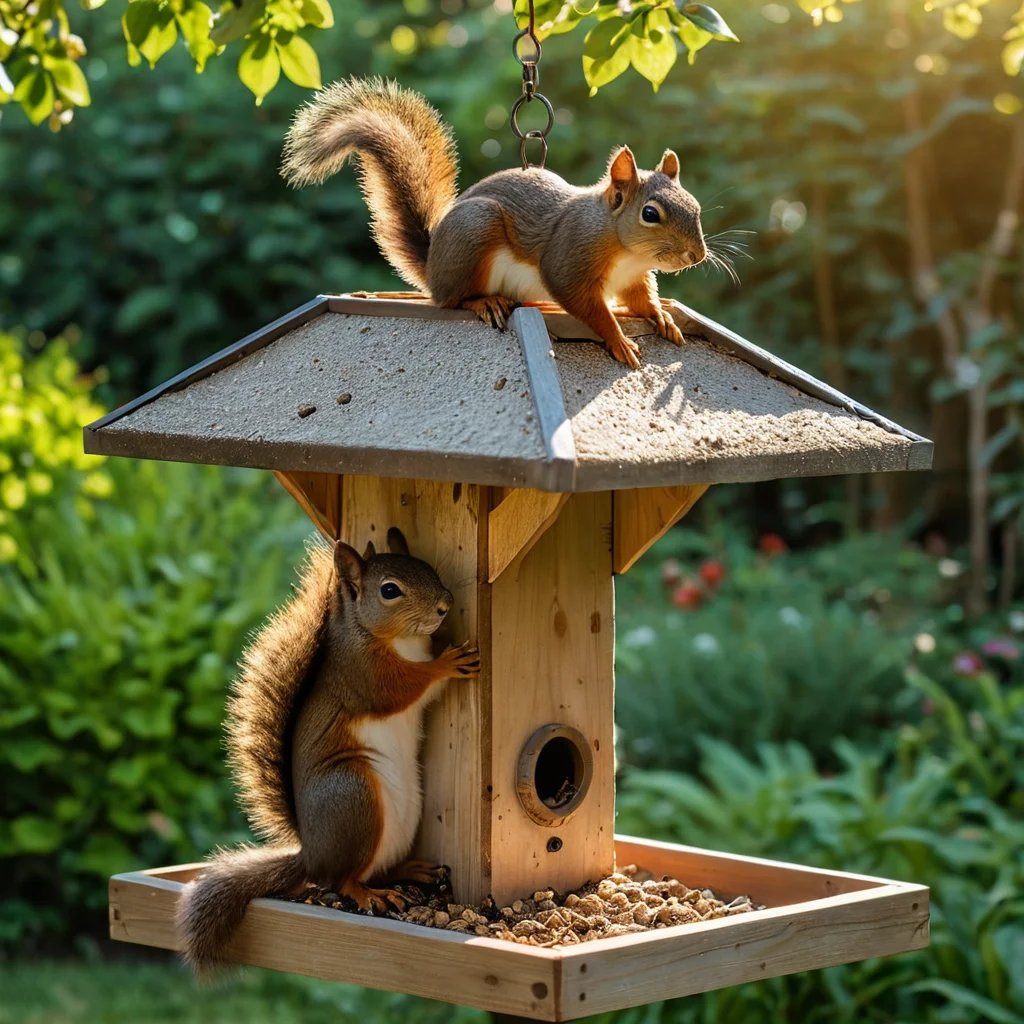
For the feeder to last long and not become a source of disease, it needs proper care. It’s not difficult, but it requires regularity.
Regular Cleaning
Frequency:
- Spring-Autumn Period: It’s advisable to clean the feeder every 1-2 weeks.
- Winter Period: The frequency of cleaning can be less, about once every 3-4 weeks, as food stores better in the cold.
How to Clean:
- Remove Residue: Shake out all old food remnants, husks, and debris from the feeder.
- Washing: If the feeder is heavily soiled, it can be washed with hot water using natural soap (or baking soda). Rinse thoroughly to remove any soap smell.
- Disinfection (if necessary): If you notice signs of mold or rot, you can treat the feeder with a baking soda solution or a weak solution of potassium permanganate (very weak!). After that, rinse thoroughly and let it dry completely.
- Drying: After washing, the feeder must be completely dried in the sun or in a dry place. A damp feeder is a breeding ground for mold and bacteria.
Maintaining Cleanliness Around the Feeder
Important Points:
- Clean up Spilled Food: It’s especially important to do this in the fall to avoid attracting rodents.
- Monitor the Feeder’s Condition: Repair loose parts and replace rotten elements in a timely manner.
Seasonal Features
- Spring: After winter, the feeder needs thorough cleaning and disinfection.
- Summer: In hot weather, food can spoil faster, so clean more often.
- Autumn: This is the busiest time for squirrels preparing for winter. Keep the food stocked and maintain cleanliness.
- Winter: Regularly replenish food and clear snow.
I try to clean my feeders every week, especially in spring and summer. I have a special brush for cleaning, and I never use chemicals. Just hot water and baking soda – and the feeder is like new. A clean feeder is the key to the health of our little neighbors.
Common Mistakes When Making and Installing Squirrel Feeders
Even the best intentions can lead to trouble if mistakes are made during the construction or installation of a feeder. Let’s look at the most common blunders so you don’t repeat them.
Manufacturing Mistakes
- Using Unsuitable Materials: As we’ve discussed, plywood, particleboard, chemically treated wood, toxic paints – all of these can harm animals.
- Small Gaps and Sharp Edges: Squirrels can get injured. All parts should be smoothly finished.
- Incorrect Entrance Hole Size: Too small – the squirrel can’t get in; too large – it will attract unwanted visitors (e.g., rats or pigeons).
- Lack of Ventilation: In a closed house without ventilation, condensation can build up, leading to food spoilage and mold growth.
- Using Regular Metal: Parts made of low-quality metal can rust and release harmful substances.
Mistakes in Location Selection and Installation
- Placement Too Low: Makes the feeder vulnerable to ground predators.
- Open, Unprotected Area: Squirrels feel insecure there and may not come.
- Too Close to Human Dwellings or Activity Zones: Noise and human movement scare animals.
- Lack of Nearby Shelters: Squirrels need to have the ability to hide quickly.
- Unreliable Fastening: The feeder can fall, scaring animals or injuring them.
Mistakes in Care and Feeding
- Infrequent Cleaning: Leads to food spoilage, mold growth, and diseases.
- Using Inappropriate Food: Salty, sweet, fried, bread – all of these are very harmful to squirrels.
- Overfeeding: Squirrels are hoarders; they don’t need a lot of food, especially if they can find it themselves.
- Leaving Spoiled Food: This is the biggest risk.
I know gardeners who have had their feeders taken over by rats. The reason was simple – too close to the compost pile and food that wasn’t cleaned up promptly. After they moved the feeder further away and started monitoring cleanliness, the problem was solved. Pay attention to the details, and your efforts will bring only joy!
Creating and installing a squirrel feeder house is a small but very significant step towards harmony in your garden. It’s an opportunity not only to decorate the plot but also to contribute to supporting wildlife. I hope my tips will help you create the perfect house that will become a favorite spot for your fluffy neighbors. May your garden be full of life, joy, and chirping!
